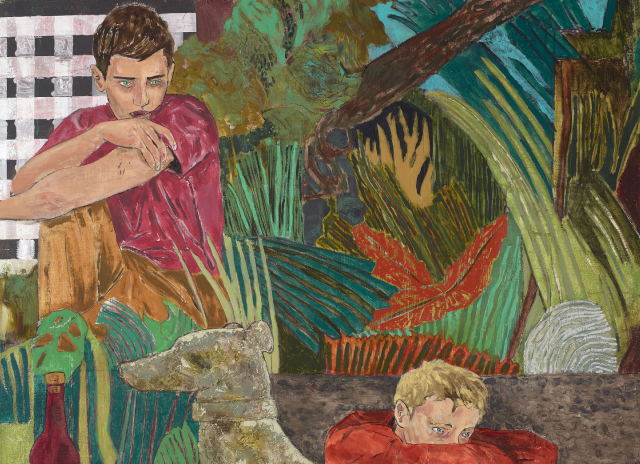
Image: Courtesy of Lehmann Maupin.

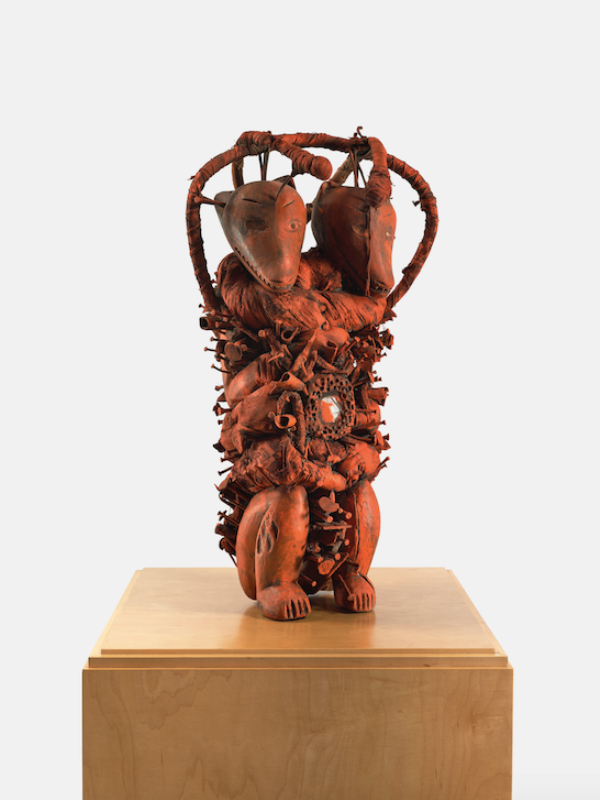
David Hammons, Orange is the New Black, 2014.
Photo Courtesy Mnuchin Gallery.
1. David Hammons at Mnuchin Gallery, through May 27.
“David Hammons: Five Decades,” the first survey in 25 years for the elusive artist, has already received a great deal of acclaim. I’ve joined the chorus not only since this is one of the most visually and aesthetically striking exhibitions in town—a must-see—but because it also touches on hot-button socio-political issues that are as pertinent today as ever, especially as the country roils in the midst of a polarizing presidential election.
Racial conflict, class struggle, an exploration of power, oppression, and the nature of authoritarianism are all explored in the 34 works on view, spanning 50 years. Hammons is a voice of the streets, of the downtrodden and the disenfranchised. There is more than a little irony in the fact that the 72-year-old artist has chosen to present this important retrospective of his work in a posh commercial gallery in Manhattan’s Upper East Side, a favorite neighborhood of the well-heeled and the empowered.
Despite the aggressive stance and assertive worldview in his work, Hammons is never merely didactic. Each of the pieces on view bears an elegant, formal beauty; his is a specific brand of street-smart poetry with an acerbic edge. The first work encountered in the show, Which Mike do you want to be like…? (2001), a work featuring three difference types of microphones, alludes to African American icons named Michael: Jackson, Jordan, and Tyson. Untitled (1989), a green glass sculpture made of empty bottles of cheap wine and booze glued together and arranged in a circular shape about three feet high, refers to the disparaging cycle of alcoholism. Decrying the disproportionate number of African Americans in US prisons, one the most potent pieces here, Orange is the New Black (2014), illuminates the problem by means of a ritual object: a Janus-headed dog. The once noble, or perhaps sacred carving has been defaced, though not destroyed, by an incongruous and disturbing coat of garish orange paint.
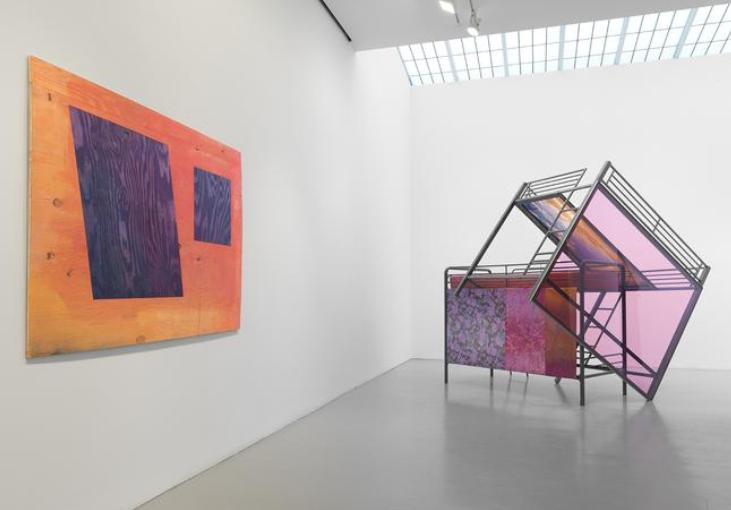
Installation view: Sarah Braman, “You are Everything,” 2016.
Photo Courtesy Mitchell-Innes & Nash.
2. Sarah Braman at Mitchell-Innes & Nash, through April 16.
Sarah Braman’s sculptures and paintings are at once monumental and ethereal. She explores light and space with spare forms and a nonchalant, almost cavalier, manipulation of materials. Nothing she does ever seems over worked or overwrought. In her fresh and airy 3-D works, she combines found objects, often abject detritus, with carefully constructed forms made of tinted glass and steel.
In this stunning show, her first solo in five years, “You are Everything,” Braman delivers a wide variety of sculptural and conceptual ideas—all engaging and some thrilling. Formally, she allies herself with minimalism, picking up where Donald Judd, Sol LeWitt, and others left off, as in Space Talk (2016). Here, a boxy, hard-edge geometric shape made of panels of blue-tinted glass in steel frames rests on a large tree stump. It recalls certain of David Shaw’s recent sculptures in its passionate plea for a more convivial balance of nature and the human-built environment.
The New York-born, Massachusetts-based artist makes a foray of sorts into architecture in this show, with a number of sculptures intended to be entered and inhabited. Driving, Sleeping, Screwing, Reading (2016), for instance, consists of part of a truck, decked out with a cushy matte floor, tinted glass windows, and lots of reading material. Recover (2016) is a smaller, and even more meditative enclosure, with a foam padded floor. Hand-dyed cloth covers the entrance, and the walls are made of translucent tinted glass, including one in a warm shade of orange-pink. Resting inside this piece offers one a view through rose-colored glasses of the rest of the exhibition, as well as a quiet refuge from the cacophony of Chelsea.
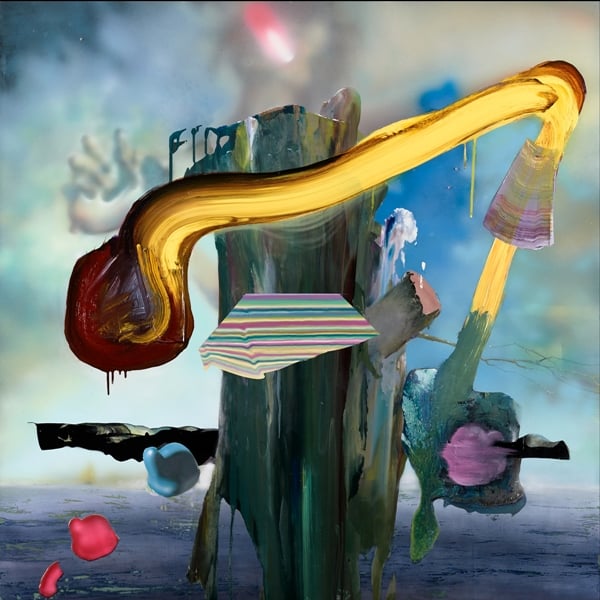
Tom LaDuke, Happy Trail, 2016.
Photo Courtesy CRG Gallery.
3. Tom LaDuke at CRG, through April 24.
In this tour-de-force exhibition of recent paintings and sculptures, Los Angeles-based artist Tom LaDuke continues an esoteric exploration of space, time, and perception, the impetus of his work for some years. At first, the paintings on view appear as abstract compositions, featuring gestural flourishes of fluid pigment of searing colors, which are certainly energetic and engaging enough. On extended and careful viewing, though, layers of refined, almost photographic images emerge in these works. Split Universe, for instance, with drips of gold from the top of the canvas and brilliant white light beams radiating from the center, harbors a detail of Diego Velázquez’s 1630 masterpiece, Apollo in the Forge of Vulcan, in the Prado’s collection, painstakingly rendered several layers deep into the surface.
More like a two-dimensional exercise in archeology, Early Signs features an impressive painterly choreography of gestures and fragmented forms that activate the foreground. The random shapes recall a rocky post, an elongated arm, and organic pod-like elements, all floating in a cosmic ether. In the background, a phantomlike image emerges based on Salvador Dalí’s iconic 1936 Surrealist painting, Soft Construction with Boiled Beans (Premonition of Civil War), from the Philadelphia Museum of Art. LaDuke offers similarly meticulous—and mind-bending—games in the 3-D works, such as Happy Trail, a life-size dandelion gone to seed, made of silicon and fingernail clippings.
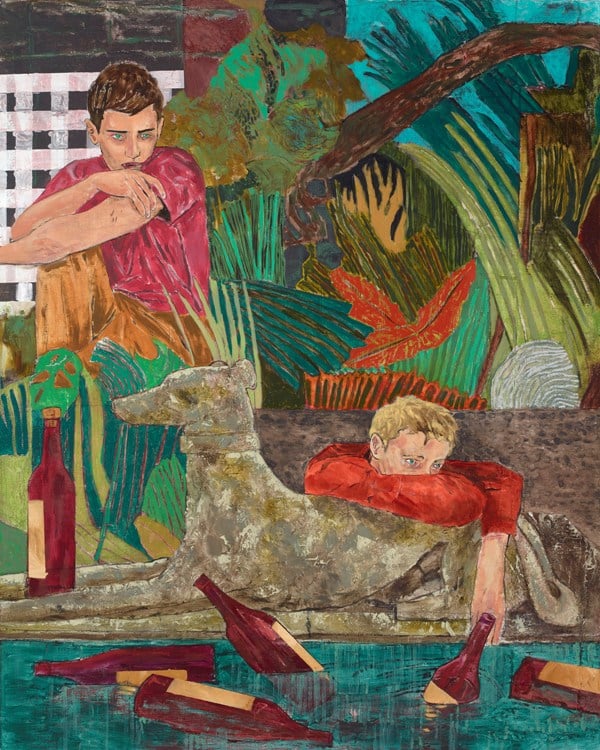
Hernan Bas, Champagne Corks Bobbed in the Pool That Morning, 2016.
Image: Courtesy of Lehmann Maupin.
4. Hernan Bas at Lehmann Maupin, through April 23.
Sensuous and sumptuous, the recent paintings and works on paper on view in this exhibition, “Bright Young Things,” are among Hernan Bas’s most convincing efforts. The Miami-born artist is well known for his exploration of queer identity in figurative compositions filled with equal doses of angst and fantasy. For this group of works, he was inspired by specific literary and art-historical sources to examine bohemian lives of artists and writers in the early decades of the 20th century. Drawing especially on D.J. Taylor’s book, Bright Young People: The Lost Generation of London’s Jazz Age as a source, Bas’s imagery centers on a critique of all things “masculine” following the catastrophic results of male aggression in World War I.
With fresh and lively brushwork, and passages of purely abstract painting inspired by Art Deco designs, works like House Training (South American Blue Flamingo), and The Haunters of First Nights, are striking and unforgettable. The former, a fantastic image, and one of my favorites here, shows two young men at a table piled with conch shells, leading a blue flamingo out of a pan of water. Champagne Corks Bobbed in the Pool That Morning, is a more subtle but equally gorgeous painting showing, as the title suggests, the melancholy, hung-over aftermath of what was, no doubt, an evening of drunken debauchery. The Roaring Twenties, indeed!
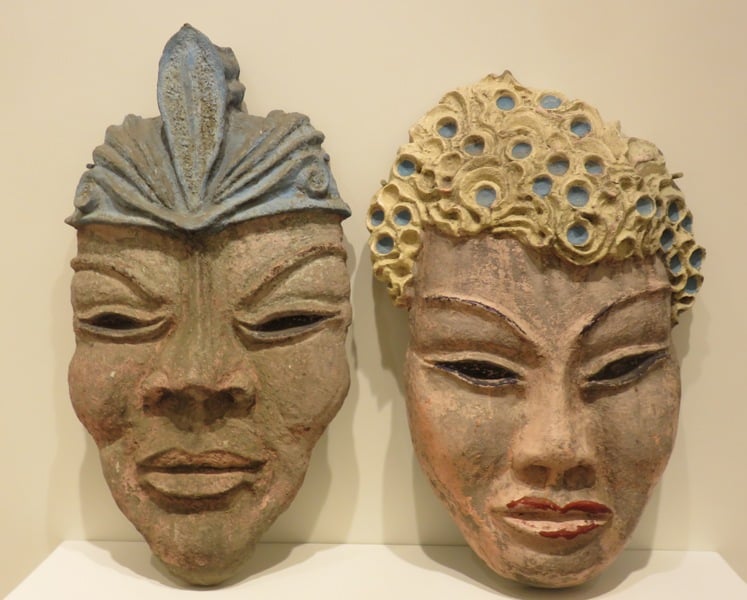
Eugene Von Bruenchenhein, Untitled (Concrete Heads), 1960s.
Photo: Courtesy Andrew Edlin Gallery.
5. Eugene Von Bruenchenhein at Andrew Edlin Gallery, through May 8.
During his lifetime, Wisconsin-born artist Eugene Von Bruenchenhein (1910–1983) was never unsure of his genius. The problem was that he almost never showed his work to anyone aside from his wife, and sometime model, Marie. Soon after his death, however, his work was brought to the attention of the John Michael Kohler Arts Center in Sheboygan; and the rest is history. Subsequently, Von Bruenchenhein’s genius as an outsider artist has been widely recognized, and today, his renown transcends the self-taught genre. He filled his house with remarkable paintings featuring hallucinatory images of futuristic landscapes and sci-fi creatures. Over the course of his lifetime, he produced hundreds of painted chicken-bone sculptures, and made fanciful ceramic pieces fired in the kitchen oven.
He also created large painted-cement heads based on imaginative tribal motifs, which he placed outdoors surrounding his house, ostensibly to ward off evil spirits. Several fine examples of these—including an oversize, if not exactly monumental, pair of male and female heads—are among the many highlights of “Eugene Von Bruenchenhein: King of Lesser Lands,” a museum-quality survey of some 60 works, on view at Andrew Edlin Gallery’s recently opened Bowery venue, across from the New Museum. On offer is a spectacular crash course in Von Bruenchenhein for those unfamiliar with his work; and for those of us already under Eugene’s spell, there are some wonderful surprises. A number of the eroticized photo portraits of Marie have been rarely or never before shown; and numerous late paintings of imaginative skyscrapers, among other pieces, are making their New York debut.
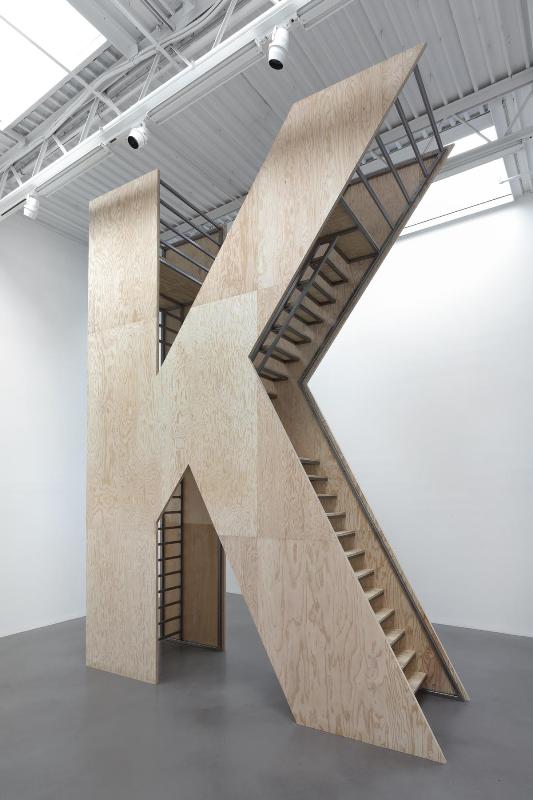
Adam McEwen, Staircase, 2016.
Photo: Courtesy Petzel Gallery.
6. Adam McEwen at Petzel, through April 30.
London-born New York-based artist Adam McEwen is not exactly out to please art audiences. His works are audacious and challenging—and very often thrilling. The dark and brooding “Harvest,” an engaging show of large-scale sculptures and paintings on sponges, is a fine example. All of the works on view address issues of movement and information gathering in a tightly controlled, Kafkaesque society—a strange and haunted place, not instantly recognizable as our own. McEwen’s consistent aim toward verisimilitude, however, results in a kind of skewed but utterly convincing form of realism.
Two imposing black objects in graphite, IBM Blue Gene 1 + 2, absorb practically all the light in the room. At first they recall Ronald Bladen’s proto-Minimalist monuments. On closer inspection, McEwen has recreated to scale huge mainframe supercomputers, or, at least their outer shells. Similarly foreboding is TSA, a sculpture consisting of graphite replicas of a table and trays like those to be scanned at airport security checkpoints. The large, black-and-white paintings of tunnels convey a sense of claustrophobia, or fragile vulnerability, as least from a security standpoint. An absurdist sculpture, perhaps, a staircase to nowhere in the shape of a giant “K,” for Kafka, directly confronts visitors. After signing an insurance waiver, determined art-goers are invited to climb up the rickety and narrow stairs to almost touch the gallery ceiling. It’s a shaky climb up, and a bit scary coming down; the heightened level of anxiety the work induces is, no doubt, the gauge of its success.
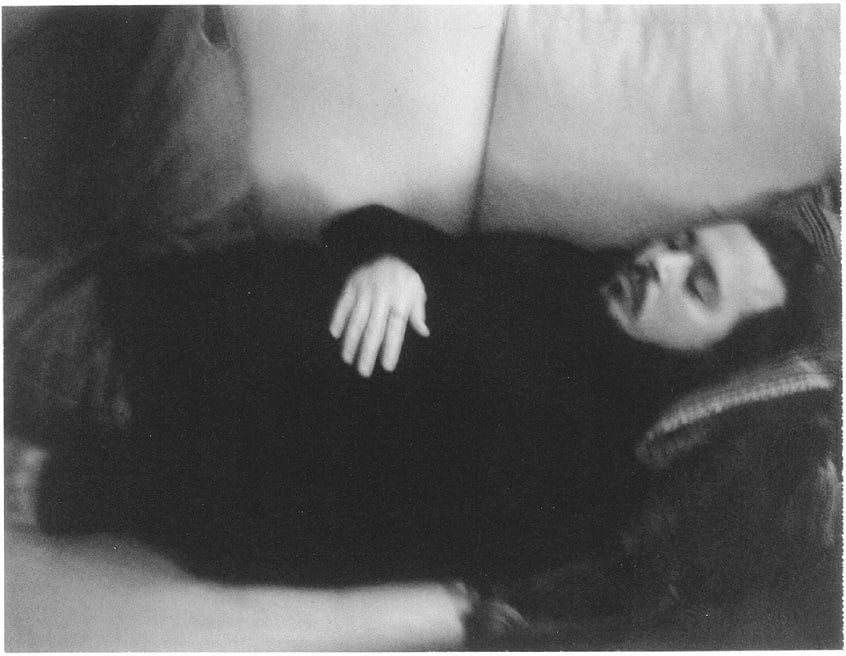
Patti Smith, Johnny Sleeping, London, 2010.
Photo: Courtesy Robert Miller Gallery.
7. Patti Smith at Robert Miller, through April 16.
For rock legend Patti Smith, music and performing have always been her bread and butter; art and literature, though, are evidently her true passions, as she underscores in her wonderful memoir M Train, published last year by Knopf Doubleday. Throughout her career, she has made paintings, drawings, and photographs in periodic bursts of creativity. Her literary output has been fairly consistent and well received—her autobiographical Just Kids won the National Book Award in 2010. Her reputation as a visual artist is a bit more tentative, although this show should significantly change the situation. “Eighteen Stations,” featuring 80 small-scale black-and-white images, is Smith’s best art-world foray I’ve seen, mainly because it’s so tightly focused—exclusively on photography. The show is an exhilarating concentration of rather ethereal images of people and places. Smith favors an old-fashioned Polaroid 250 Land Camera, and the images have an antique, dreamy look, often slightly out of focus, as if she used a pinhole camera à la Barbara Ess.
Smith’s works here are evocative and thought-provoking, conveying a conceptual breadth that belies the diminutive scale. Most are gelatin silver prints, although there are a number of digital ink jets pieces, including portraits of her friends, such as Johnny Depp (Johnny Sleeping, London, 2010), and Sam Shepard, Central Park (2012). Overall, the pictures correspond to the narrative of M Train—some are reproduced in the book, and others complement this story of a life motivated and inspired by art, artists, writing and writers. Like the book, the photos trace a personal journey, sometimes literally, as when she recounts a trip to South America with her late husband, musician Fred “Sonic” Smith, in the early 1980s. Before raising a family, she wanted to visit French Guiana to see the remains of a penal colony, which had obsessed one of her literary heroes, Jean Genet. Photos from that trip are among show’s highlights. Elsewhere, she pays homage to other major inspirations, including Frida Kahlo, Roberto Bolaño, and Virginia Woolf.
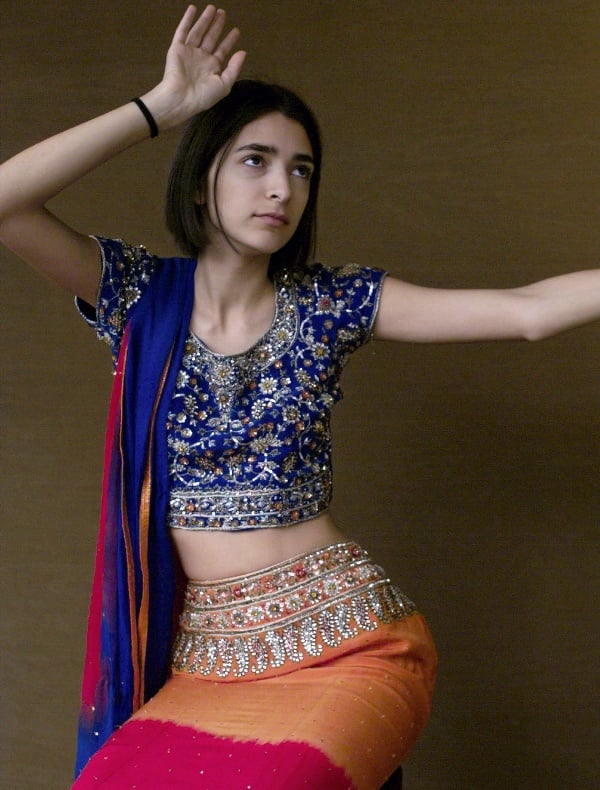
James Nares, Jahanara, video, 2015.
Photo: Courtesy Paul Kasmin Gallery.
8. James Nares at Paul Kasmin Gallery, through April 23.
At first there doesn’t seem to be much action in James Nares’s video portraits. The images of his sitters—mostly the artist’s friends and art-world denizens, such as Douglas Crimp, Jim Jarmusch, Amy Taubin, Walter Robinson, and Glenn O’Brien, as well as the artist’s daughters, Sasha, Zarina, and Jahanara—appear rather static, as if these were still images in a photography show. However, given time, a tense drama slowly unfolds in each of the videos, which are presented as life-size portraits on vertically hung monitors. Subtle hand movements, a blink of an eye, or a gentle shift in pose begin to seem like heightened drama.
Filmed wearing a luminous Indian sari, and engaged in a graceful dance, Jahanara is one of the most animated of the portrait subjects. Known for hyper-energized paintings featuring single, convulsive gestural brushstrokes, Nares, in this show, uses high-speed cameras to capture at several hundred frames per second a sense of motion, or what the artist describes in a press statement as “micro-moments.” After a while, the sitters, despite their formal comportment, set against stark neutral backgrounds, become even more lifelike and mesmerizing.
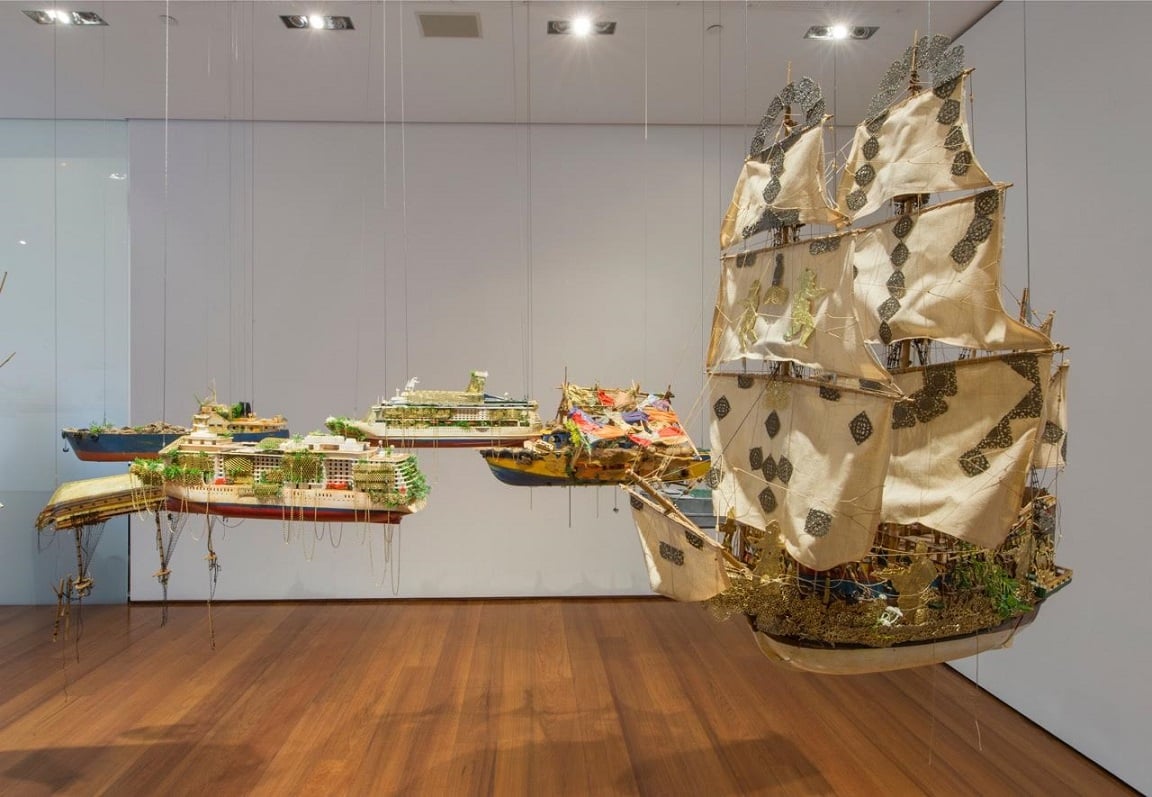
Installation view, Hew Locke, “The Wine Dark Sea.”
Photo Courtesy Edward Tyler Nahem Fine Art.
9. Hew Locke at Edward Tyler Nahem, through April 13.
Hew Locke’s 2014 exhibition in Prospect 3 in New Orleans, “The Nameless,” made an indelible impression on me. The Scotland-born artist spent his formative years in Guyana, and has been showing internationally for some time. In New Orleans, he presented murals depicting fantastical creatures and characters based on Caribbean mythology, made of countless strands of glittering black Marti-Gras beads and black rope, like that used by Bayou fishermen. Incredibly, Locke has never had a one-person show in New York until now. This exhibition, “The Wine Dark Sea,” titled after a line in Homer’s The Odyssey, marks his solo debut here, and is appropriately momentous and revelatory.
The theme he chose for the show is nautical migration, alluding to the waves of refugees fleeing war-ravaged lands and obsessive regimes around the globe today. Suspended from the ceiling, and hanging several feet above the gallery floor, are dozens of elaborately outfitted toy boats, and intricately detailed model ships—some prefabricated and elaborately embellished by the artist, and others created from scratch. This crowded flotilla sails toward the gallery’s windows, as if to proceed onto the city’s streets. With vessels ranging from Chinese junks to luxury ocean liners, Locke suggests that the boats are all filled with people and goods; the refugees seek a better life in a more hospitable world, a place of redemption, renewal, and hope.
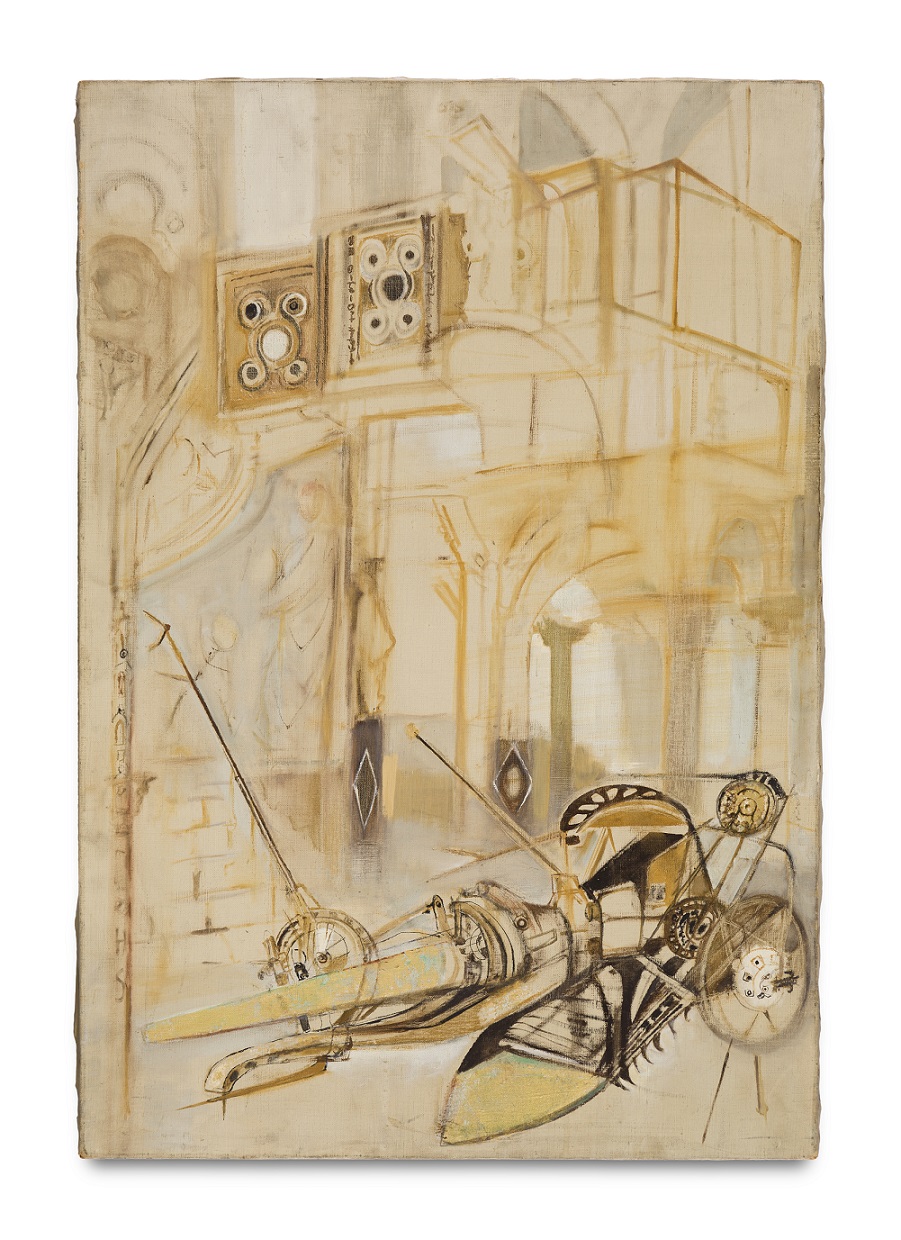
Hedda Sterne, Untitled, c. 1950.
Photo Courtesy Van Doren Waxter.
10. Hedda Sterne at Van Doren Waxter, through April 29.
Hedda Sterne was the only woman artist included in the famous—or infamous—Life magazine photograph of the prominent New York Abstract Expressionists, “The Irascibles,” published in 1951. She died in 2011, age 100, after having worked for most of her life in obscurity, while her male “Irascibles” colleagues, including Pollock, Rothko, de Kooning, and Motherwell, et. al., went on to international renown. This remarkable and much-needed exhibition, “Hedda Sterne: Machines 1947–1951,” including some 16 major paintings and works on paper, aims to illuminate Sterne’s singular contribution to 20th-century art.
In the late 1930s, Sterne escaped the Nazis in her hometown, Bucharest, Romania, and immigrated to New York. Her works of the period are Surrealist influenced, as in a number of later pieces on view, in which her spiky machine forms recall certain works by Marcel Duchamp or Roberto Matta. Monument (1949–51), a tall, vertical canvas with a pale blue background, features an imaginative architectural form, a totem-like tower of talismanic purpose, perhaps. In other works, the machine forms seem rather ominous, as if the artist disparages the Industrial Age. In a particularly potent painting, Untitled (circa 1950), the elongated machine form on the lower right seems organic, and rather animistic, like a venomous, winged insect about to strike.